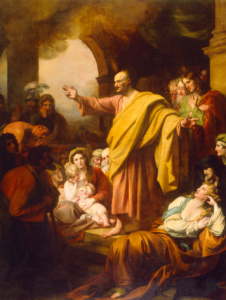Object of the Month: September 2020
St. Peter Preaching at Pentecost
Oil on canvas, signed and dated 1785
Benjamin West, P.R.A.
American, active in England, 1738–1820
Benjamin West was born the youngest of ten children to Quakers John and Sarah West on October 10, 1738 in the township of Springfield, Pennsylvania. At an early age, he showed remarkable artistic talent by painting likenesses of his family. True or not, charming anecdotes have been passed down that the Indians instructed him in preparing colors and that Benjamin made his first paintbrush by plucking tail and back hairs from Gremalkin, the family cat.
At nine, he met a British portraitist, William Williams, who genuinely inspired the young boy. He lent West two books about painting, which developed in him an enduring interest in both the great historians who recorded the stories of the noble and virtuous and the great master painters who depicted the lofty scenes of Scripture and the past.
West continued to paint portraits and at age 18, following his mother’s death, he moved to Philadelphia to live with his married sister. There, he benefited from the mentoring of Rev. William Smith, a respected scholar, minister, and intellectual. Smith found a way for West (age 22, armed with letters of introduction) to travel to Rome, where the great artists studied. West was the first American artist to travel to Italy, where he not only studied and copied the Old Masters and sculpture of Greek and Roman antiquity, but he befriended the contemporary Neoclassical painters including Anton Raphael Mengs and Pompeo Batoni.
In 1763, West moved to England and joined the Society of Artists, where he exhibited and earned the nickname, “the American Raphael”—it was the beginning of a successful career and a lifetime of commissions. Along with Sir Joshua Reynolds and other artists, the king made West a charter member of the Royal Academy.
Defying precedent, West pursued a controversial approach in 1770 for the first exhibition of the Royal Academy by painting The Death of General Wolfe. The scene portrayed a moment of recent history—the heroic death of a great general during Britain’s Seven Years War with France in North America. Rather than following the day’s expectation of clothing the characters in robes of antiquity, West painted the men wearing modern dress. It was a milestone in English and American art, and it established his artistic reputation.
West became England’s leading Neoclassical painter and historical painter to King George III. Following Reynolds’ death, West was made the 2nd president of the Royal Academy and the longest serving. West’s success and recognition attracted art students from America. He gave them opportunities to study and assist on commissions in his studio, where he trained three generations of American artists, including Charles Wilson Peale and Gilbert Stuart. As the “Father of American Painting,” he helped establish a sophisticated American style and provided a foundation for the growth of the arts in America during the Federal period.
In 1780, King George commissioned West to decorate a proposed chapel at Windsor Castle “for the purpose of displaying a pictorial illustration” of subjects from the Bible, “which Christians of all denominations, might contemplate without offense to their tenets.” West developed multiple plans for the chapel over a 20-year period, so it is difficult to know the total paintings he intended to complete. According to records from 1801, his concept for the Chapel of the History of Revealed Religion contained approximately 35 paintings featuring the Scriptural events when God specifically revealed Himself to man.
M&G’s St. Peter Preaching at Pentecost is one of the paintings originally planned for the king’s chapel. The festival of Pentecost brought many visitors from around the known world to Jerusalem. The disciples were gathered together on the feast day when suddenly the sound of a rushing wind filled the house. Flames of fire appeared above their heads, and they were filled with the Holy Spirit and began to speak in other languages. Others at the feast thought the disciples were drunk, but Peter powerfully preached to the assembled crowd, who understood what he spoke in their own language. He explained to them that the miracle they were observing was the fulfillment of Joel’s prophecy and that Jesus came to save them from their sins, died, and was resurrected on the third day. Three thousand people believed on Jesus Christ that day.
West beautifully and subtly displays this New Testament event from Acts 2, by representing the presence of the Holy Spirit with a smoky quality and the slightest hint of faintly glowing flames above Peter’s head and John’s (behind Peter and wearing green and red). The crowd scene is an observer’s study in reading people. Each person responds differently as they intently consider the apostle’s words. One of West’s special details is the mother with her two young children, which references his skill as a portraitist.
Of course, many factors prevented the chapel and commission from being finished including the American and French Revolutions and the king’s ongoing health struggles. However, West completed 18 large paintings for the chapel and left one unfinished. Of those 18 finished works, 5 are now lost, which leaves 13 paintings with known locations. Six can be found in the collections at the National Gallery in DC, the Pennsylvania Academy of Fine Art, the Palace of Westminster in London, the Tate Gallery, Margram Castle in Neath, and St. Martin’s Church in Wales. Remarkably, M&G displays the remaining 7 paintings all together in the War Memorial Chapel on the campus of Bob Jones University.
These are no ordinary pictures, and they represent the creative talent and skill of the first, significant American artist. Art historian Alfred Scharf has honored these works as “the most outstanding series of religious paintings in 18th-century England.”
Erin R. Jones, Executive Director
Published in 2020
